NOTE: This article has been archived. Please read our new "Types of Lithium-ion" for an updated version.
Most lithium-ion batteries for portable applications are cobalt-based. The system consists of a cobalt oxide positive electrode (cathode) and a graphite carbon in the negative electrode (anode). One of the main advantages of the cobalt-based battery is its high energy density. Long run-time makes this chemistry attractive for cell phones, laptops and cameras.
| The widely used cobalt-based lithium-ion has drawbacks; it offers a relatively low discharge current. A high load would overheat the pack and its safety would be jeopardized. The safety circuit of the cobalt-based battery is typically limited to a charge and discharge rate of about 1C. This means that a 2400mAh 18650 cell can only be charged and discharged with a maximum current of 2.4A. Another downside is the increase of the internal resistance that occurs with cycling and aging. After 2-3 years of use, the pack often becomes unserviceable due to a large voltage drop under load that is caused by high internal resistance. Figure 1 illustrates the crystalline structure of cobalt oxide. | 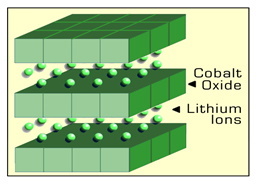 |
| Figure 1: Cathode crystalline of lithium cobalt oxide has 'layered' structures. The lithium ions are shown bound to the cobalt oxide. During discharge, the lithium ions move from the cathode to the anode. The flow reverses on charge. |
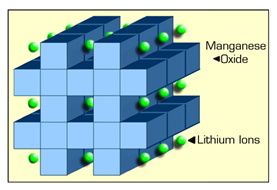 | In 1996, scientists succeeded in using lithium manganese oxide as a cathode material. This substance forms a three-dimensional spinel structure that improves the ion flow between the electrodes. High ion flow lowers the internal resistance and increases loading capability. The resistance stays low with cycling, however, the battery does age and the overall service life is similar to that of cobalt. Spinel has an inherently high thermal stability and needs less safety circuitry than a cobalt system.Low internal cell resistance is the key to high rate capability. This characteristic benefits fast-charging and high-current discharging. A spinel-based lithium-ion in an 18650 cell can be discharged at 20-30A with marginal heat build-up. Short one-second load pulses of twice the specified current are permissible. Some heat build-up cannot be prevented and the cell temperature should not exceed 80°C. |
| Figure 2: Cathode crystalline of lithium manganese oxide has a 'three-dimensional framework structure'. This spinel structure, which is usually composed of diamond shapes connected into a lattice, appears after initial formation. This system provides high conductivity but lower energy density. |
The spinel battery also has weaknesses. One of the most significant drawbacks is the lower capacity compared to the cobalt-based system. Spinel provides roughly 1200mAh in an 18650 package, about half that of the cobalt equivalent. In spite of this, spinel still provides an energy density that is about 50% higher than that of a nickel-based equivalent. | 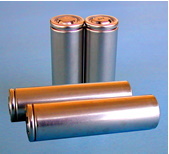 | Figure 3: Format of 18650 cell. The dimensions of this commonly used cell are: 18mm in diameter and 65mm in length. |
Types of lithium-ion batteries
Lithium-ion has not yet reached full maturity and the technology is continually improving. The anode in today's cells is made up of a graphite mixture and the cathode is a combination of lithium and other choice metals. It should be noted that all materials in a battery have a theoretical energy density. With lithium-ion, the anode is well optimized and little improvements can be gained in terms of design changes. The cathode, however, shows promise for further enhancements. Battery research is therefore focusing on the cathode material. Another part that has potential is the electrolyte. The electrolyte serves as a reaction medium between the anode and the cathode.
The battery industry is making incremental capacity gains of 8-10% per year. This trend is expected to continue. This, however, is a far cry from Moore's Law that specifies a doubling of transistors on a chip every 18 to 24 months. Translating this increase to a battery would mean a doubling of capacity every two years. Instead of two years, lithium-ion has doubled its energy capacity in 10 years.
Today's lithium-ion comes in many "flavours" and the differences in the composition are mostly related to the cathode material. Table 1 below summarizes the most commonly used lithium-ion on the market today. For simplicity, we summarize the chemistries into four groupings, which are Cobalt, Manganese, NCM and Phosphate.
Chemical name | Material | Abbreviation | Short form | Notes |
Lithium Cobalt Oxide1Also Lithium Cobalate or lithium-ion-cobalt) | LiCoO2 | LCO | Li-cobalt | High capacity; for cell phone laptop, camera |
Lithium | LiMn2O4 | LMO | Li-manganese, or spinel | Most safe; lower capacity than Li-cobalt but high specific power and long life. Power tools, |
Lithium | LiFePO4 | LFP | Li-phosphate | |
Lithium Nickel Manganese Cobalt Oxide1, also lithium-manganese-cobalt-oxide | LiNiMnCoO2 | NMC | NMC | |
Lithium Nickel Cobalt Aluminum Oxide1 | LiNiCoAlO2 | NCA | NCA | Gaining importance |
Lithium Titanate2 | Li4Ti5O12 | LTO | Li-titanate |
Table 1: Reference names for Li-ion batteries.We willuse the short form when appropriate.
1 Cathode material
2 Anode material
The cobalt-based lithium-ion appeared first in 1991, introduced by Sony. This battery chemistry gained quick acceptance because of its high energy density. Possibly due to lower energy density, spinel-based lithium-ion had a slower start. When introduced in 1996, the world demanded longer runtime above anything else. With the need for high current rate on many portable devices, spinel has now moved to the frontline and is in hot demand. The requirements are so great that manufacturers producing these batteries are unable to meet the demand. This is one of the reasons why so little advertising is done to promote this product. E-One Moli Energy (Canada) is a leading manufacturer of the spinel lithium-ion in cylindrical form. They are specializing in the 18650 and 26700 cell formats. Other major players of spinel-based lithium-ion are Sanyo, Panasonic and Sony.
Sony is focusing on the nickel-cobalt manganese (NCM) version. The cathode incorporates cobalt, nickel and manganese in the crystal structure that forms a multi-metal oxide material to which lithium is added. The manufacturer offers a range of different products within this battery family, catering to users that either needs high energy density or high load capability. It should be noted that these two attributes could not be combined in one and the same package; there is a compromise between the two. Note that the NCM charges to 4.10V/cell, 100mV lower than cobalt and spinel. Charging this battery chemistry to 4.20V/cell would provide higher capacities but the cycle life would be cut short. Instead of the customary 800 cycles achieved in a laboratory environment, the cycle count would be reduced to about 300.
The newest addition to the lithium-ion family is the A123 System in which nano-phosphate materials are added in the cathode. It claims to have the highest power density in W/kg of a commercially available lithium-ion battery. The cell can be continuously discharged to 100% depth-of-discharge at 35C and can endure discharge pulses as high as 100C. The phosphate-based system has a nominal voltage of about 3.3V/cell and peak charge voltage is 3.60V. This is lower than the cobalt-based lithium-ion and the battery will require a designated charger. Valance Technology was the first to commercialize the phosphate-based lithium-ion and their cells are sold under the Saphionâ name.
In Figure 4 we compare the energy density (Wh/kg) of the three lithium-ion chemistries and place them against the traditional lead acid, nickel-cadmium, nickel-metal-hydride. One can see the incremental improvement of Manganese and Phosphate over older technologies. Cobalt offers the highest energy density but is thermally less stable and cannot deliver high load currents.
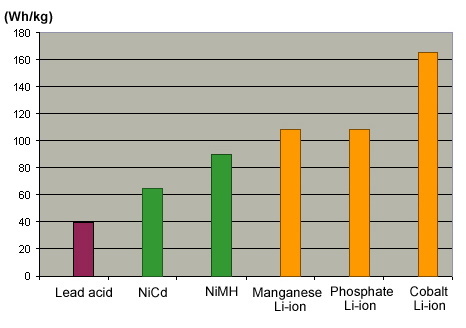 | Figure 4: Energy densities of common battery chemistries. |
Definition of Energy Density and Power Density
Energy Density (Wh/kg) is a measure of how much energy a battery can hold. The higher the energy density, the longer the runtime will be. Lithium-ion with cobalt cathodes offer the highest energy densities. Typical applications are cell phones, laptops and digital cameras.
Power Density (W/kg) indicates how much power a battery can deliver on demand. The focus is on power bursts, such as drilling through heavy steel, rather than runtime. Manganese and phosphate-based lithium-ion, as well as nickel-based chemistries, are among the best performers. Batteries with high power density are used for power tools, medical devices and transportation systems.
An analogy between energy and power densities can be made with a water bottle. The size of the bottle is the energy density, while the opening denotes the power density. A large bottle can carry a lot of water, while a large opening can pore it quickly. The large container with a wide mouth is the best combination.
Confusion with voltages
For the last 10 years or so, the nominal voltage of lithium-ion was known to be 3.60V/cell. This was a rather handy figure because it made up for three nickel-based batteries (1.2V/cell) connected in series. Using the higher cell voltages for lithium-ion reflects in better watt/hours readings on paper and poses a marketing advantage, however, the equipment manufacturer will continue assuming the cell to be 3.60V.
The nominal voltage of a lithium-ion battery is calculated by taking a fully charged battery of about 4.20V, fully discharging it to about 3.00V at a rate of 0.5C while measuring the average voltage.
Because of the lower internal resistance, the average voltage of a spinel system will be higher than that of the cobalt-based equivalent. Pure spinel has the lowest internal resistance and the nominal cell voltage is 3.80V. The exception again is the phosphate-based lithium-ion. This system deviates the furthest from the conventional lithium-ion system
Prolonged battery life through moderation
Batteries live longer if treated in a gentle manner. High charge voltages, excessive charge rate and extreme load conditions have a negative effect on battery life. The longevity is often a direct result of the environmental stresses applied. The following guidelines suggest ways to prolong battery life.
-The time at which the battery stays at 4.20/cell should be as short as possible. Prolonged high voltage promotes corrosion, especially at elevated temperatures. Spinel is less sensitive to high voltage.
-3.92V/cell is the best upper voltage threshold for cobalt-based lithium-ion. Charging batteries to this voltage level has been shown to double cycle life. Lithium-ion systems for defense applications make use of the lower voltage threshold. The negative is a much lower capacity.
-The charge current of Li-ion should be moderate (0.5C for cobalt-based lithium-ion). The lower charge current reduces the time in which the cell resides at 4.20V. A 0.5C charge only adds marginally to the charge time over 1C because the topping charge will be shorter. A high current charge tends to push the voltage into voltage limit prematurely.
-Do not discharge lithium-ion too deeply. Instead, charge it frequently. Lithium-ion does not have memory problems like nickel-cadmium batteries. No deep discharges are needed for conditioning.
-Do not charge lithium-ion at or below freezing temperature. Although accepting charge, an irreversible plating of metallic lithium will occur that compromises the safety of the pack.
Not only does a lithium-ion battery live longer with a slower charge rate; moderate discharge rates also help. Figure 5 shows the cycle life as a function of charge and discharge rates. Observe the improved laboratory performance on a charge and discharge rate of 1C compared to 2 and 3C.
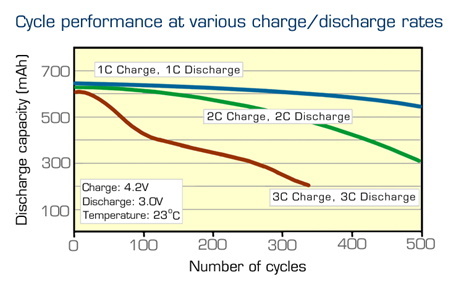 | Figure 5: Longevity of lithium-ion as a function of charge and discharge rates. Lithium-cobalt enjoys the highest energy density. Manganese and phosphate systems are terminally more stable and deliver high load currents than cobalt. |
Battery experts agree that the longevity of lithium-ion is shortened by other factors than charge and discharge rates. Even though incremental improvements can be achieved with careful use, our environment and the services required are not always conducive for optimal battery life. In this respect, the battery behaves much like us humans - we cannot always live a life that caters to achieve maximum life span.
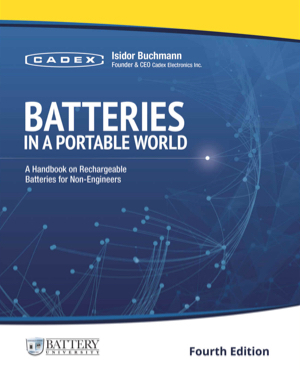
Comments
Looking for comments from the previous website?
Comments from the previous website are not compatible with our new commenting system but we have preserved them so our users can still reference and make use the information in them.
